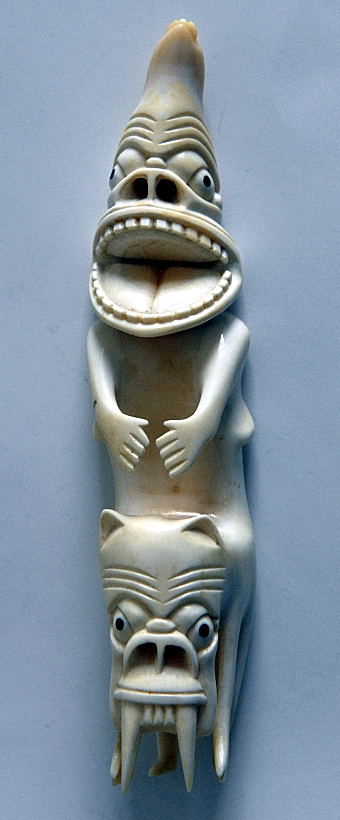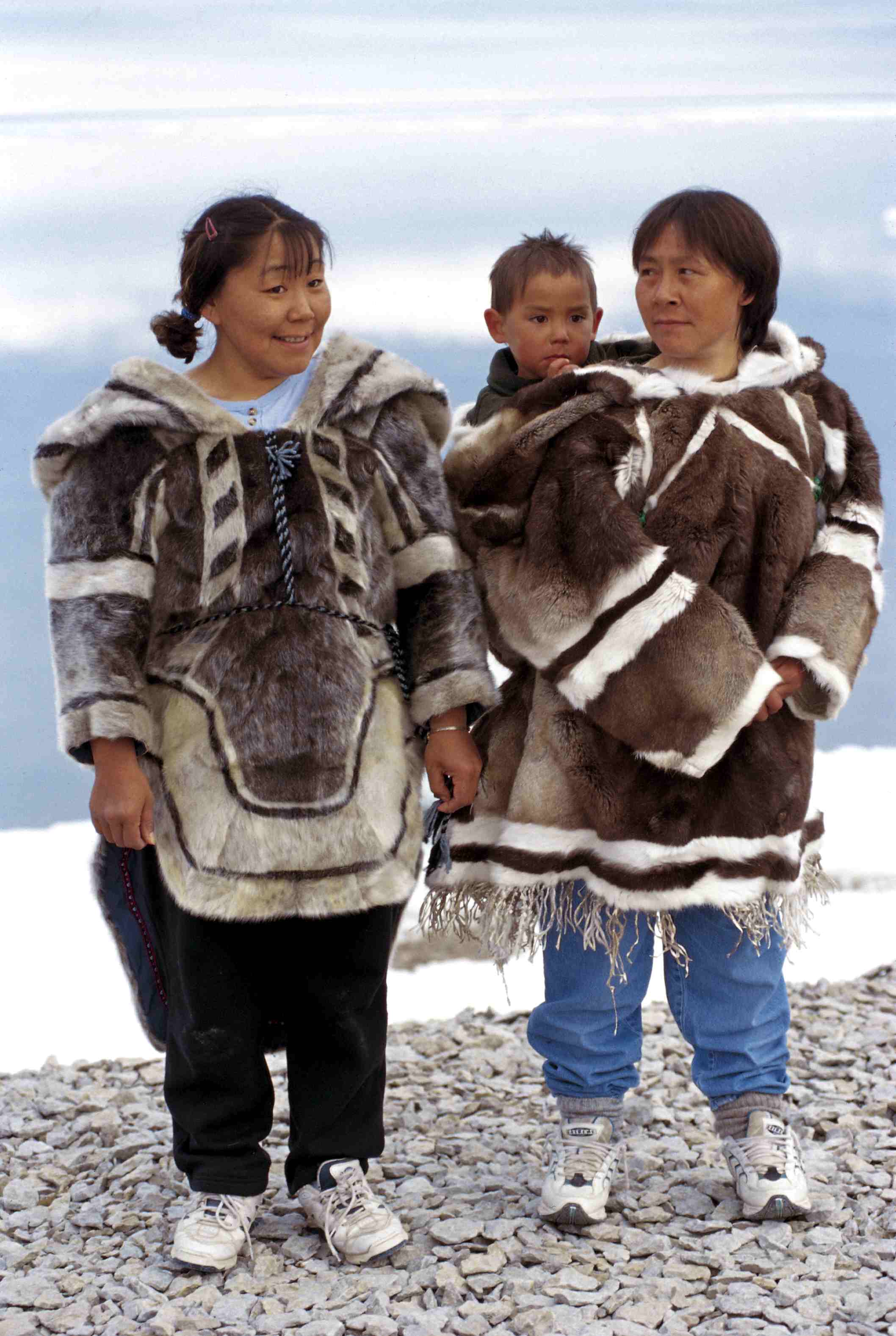|
Tupilait
A ( or in Inuktitut syllabics, plural ) is a monster or carving of a monster. In Inuit religion, especially in Greenland, a tupilaq was an avenging monster fabricated by an angakkuq (a practitioner of witchcraft or shamanism) by using various objects such as animal parts (bone, skin, hair, sinew, etc.) and even parts taken from the corpses of children. The creature was given life by ritualistic chants. It was then placed into the sea to seek and destroy a specific enemy. The use of tupilaq was considered risky, as if it was sent to destroy someone who had greater magical powers than the one who had formed it, it could be sent back to kill its maker instead,Kleivan & Sonne 1985: 23; Plate XLIII, XLV although the maker of the tupilaq could escape by public confession of their deed. Because tupilaq were made in secret, in isolated places and from perishable materials, none have been preserved. Early European visitors to Greenland, fascinated by the native legend, were eager to s ... [...More Info...] [...Related Items...] OR: [Wikipedia] [Google] [Baidu] |
Greenlandic Inuit
The Greenlandic Inuit or sometimes simply the Greenlandic are an ethnic group and nation Indigenous peoples of the Americas, indigenous to Greenland, where they constitute the largest ethnic population. They share a common #History, ancestry, Culture of Greenland, culture, and History of Greenland, history; and natively speak the Greenlandic language. As Greenland is a territory within the Danish Realm, citizens of Greenland are both Danish nationality law, citizens of Denmark and European Union citizenship, of the European Union. Approximately 89 percent of Greenland's population of 57,695 is Greenlandic Inuit, or 51,349 people . Ethnographically, they consist of three major groups: * the Kalaallit of west Greenland, who speak West Greenlandic, Kalaallisut * the Tunumiit of Tunu (east Greenland), who speak Tunumiit language, Tunumiit oraasiat ("East Greenlandic") * the Inughuit of north Greenland, who speak Inuktun ("Polar Inuit") Historically, ''Kalaallit'' referred specific ... [...More Info...] [...Related Items...] OR: [Wikipedia] [Google] [Baidu] |
Taboo
A taboo is a social group's ban, prohibition or avoidance of something (usually an utterance or behavior) based on the group's sense that it is excessively repulsive, offensive, sacred or allowed only for certain people.''Encyclopædia Britannica Online''.Taboo. Encyclopædia Britannica Inc., 2012. Retrieved 21 Mar. 2012 Such prohibitions are present in virtually all societies. Taboos may be prohibited explicitly, for example within a legal system or religion, or implicitly, for example by social norms or conventions followed by a particular culture or organization. Taboos are often meant to protect the individual, but there are other reasons for their development. An ecological or medical background is apparent in many, including some that are seen as religious or spiritual in origin. Taboos can help use a resource more efficiently, but when applied to only a subsection of the community they can also serve to suppress said subsection of the community. A taboo acknowledged by a ... [...More Info...] [...Related Items...] OR: [Wikipedia] [Google] [Baidu] |
Torngarsuk
In the Inuit religion, Torngarsuk (or Torngasak) is a sea, death and underworld god, one of the more important deities in the Inuit pantheon. He is said to be the leader of the Tornat, a group of protective gods. Torngarsuk is listed as a demon or spirit in the ''Dictionnaire Infernal'', a.k.a. Tornatik, Torngarsoak, Torngasoak, Tungrangayak, Tornasuk etc., is a mischievous demon/spirit worshiped by offering in Greenland and the northeastern regions of Canada. Description Torngarsuk is the master of whales and seals and most powerful supernatural being in Greenland. He appears in the form of a bear, or a one-armed man, or as a grand human creature like one of the fingers of a hand. He is considered to be invisible to everyone but the '' angakkuit'' (the medicine men or shaman among Inuit peoples). These conflicting descriptions leave us unsure as to his form, but as a grand spirit or demon Torngarsuk is invoked by fishermen and by the when one falls ill. There are other spiri ... [...More Info...] [...Related Items...] OR: [Wikipedia] [Google] [Baidu] |
Tikoloshe
In Nguni mythology, the tokoloshe, tikoloshe, tikolosh, tonkolosh, tonkolosi, tokolotshe, thokolosi, or hili is a dwarf-like water spirit. It is a mischievous and evil spirit that can become invisible by drinking water or swallowing a stone. Tokoloshes are called upon by malevolent people to cause trouble for others. At its least harmful, a tokoloshe can be used to scare children, but its power extends to causing illness or even the death of the victim. Protection against them includes traditional methods such as raising beds off the ground and interventions by spiritual figures like pastors with an apostolic calling or traditional healers ( sangomas), who are seen to possess the power to banish them. The tokoloshe is often referenced satirically to critique the influence of superstitions on behaviour and society. Mythology The advent of the phantom tokoloshe came about through Bantu folklore to explain why people inexplicably died while sleeping in their rondavels at nig ... [...More Info...] [...Related Items...] OR: [Wikipedia] [Google] [Baidu] |
Anchimayen
The Anchimayen (in the Mapudungun language, also spelled "Anchimallén" or "Anchimalguén" in Spanish) is a mythical creature in Mapuche mythology. Anchimayens are described as little creatures that take the form of small children, and can transform into flying fireballs that emit bright light. They are the servants of a kalku (a type of Mapuche sorcerer). According to some sources, the goddess she was originally conceived of as the moon goddess, married to the sun, but later developed into a (will-o'-the-wisp) type being that frightens and unhorses travelers. Anchimayens are sometimes confused with Kueyen (the Mapuche lunar goddess), because she also produces a bright light. See also * Ball lightning Ball lightning is a rare and unexplained phenomenon described as Luminosity, luminescent, spherical objects that vary from pea-sized to several meters in diameter. Though usually associated with thunderstorms, the observed phenomenon is repor ... * Energy being * Tupila ... [...More Info...] [...Related Items...] OR: [Wikipedia] [Google] [Baidu] |
Christianity
Christianity is an Abrahamic monotheistic religion, which states that Jesus in Christianity, Jesus is the Son of God (Christianity), Son of God and Resurrection of Jesus, rose from the dead after his Crucifixion of Jesus, crucifixion, whose coming as the Messiah#Christianity, messiah (Christ (title), Christ) was Old Testament messianic prophecies quoted in the New Testament, prophesied in the Old Testament and chronicled in the New Testament. It is the Major religious groups, world's largest and most widespread religion with over 2.3 billion followers, comprising around 28.8% of the world population. Its adherents, known as Christians, are estimated to make up a majority of the population in Christianity by country, 157 countries and territories. Christianity remains Christian culture, culturally diverse in its Western Christianity, Western and Eastern Christianity, Eastern branches, and doctrinally diverse concerning Justification (theology), justification and the natur ... [...More Info...] [...Related Items...] OR: [Wikipedia] [Google] [Baidu] |
Devil
A devil is the mythical personification of evil as it is conceived in various cultures and religious traditions. It is seen as the objectification of a hostile and destructive force. Jeffrey Burton Russell states that the different conceptions of the devil can be summed up as 1) a principle of evil independent from God, 2) an aspect of God, 3) a created being turning evil (a '' fallen angel'') or 4) a symbol of human evil. Each tradition, culture, and religion with a devil in its mythos offers a different lens on manifestations of evil.Jeffrey Burton Russell, ''The Devil: Perceptions of Evil from Antiquity to Primitive Christianity'', Cornell University Press 1987 , pp. 41–75 The history of these perspectives intertwines with theology, mythology, psychiatry, art, and literature, developing independently within each of the traditions. It occurs historically in many contexts and cultures, and is given many different names— Satan (Judaism), Lucifer (Christianity), Bee ... [...More Info...] [...Related Items...] OR: [Wikipedia] [Google] [Baidu] |
Chimera (mythology)
According to Greek mythology, the Chimera, Chimaera, Chimæra, or Khimaira ( ; ) was a monstrous fire-breathing hybrid creature from Lycia, Asia Minor, composed of different animal parts. Typically, it is depicted as a lion with a goat's head protruding from its back and a tail ending with a snake's head. Some representations also include dragon's wings. It was an offspring of Typhon and Echidna and a sibling of monsters like Cerberus and the Lernaean Hydra. The term "chimera" has come to describe any mythical or fictional creature with parts taken from various animals, to describe anything composed of disparate parts or perceived as wildly imaginative, implausible, or dazzling. In other words, a chimera can be any hybrid creature. In figurative use, derived from the mythological meaning, "chimera" refers to an unrealistic, or unrealisable, wild, foolish or vain dream, notion or objective. Family According to Hesiod, the Chimera's mother was a certain ambiguous "she", wh ... [...More Info...] [...Related Items...] OR: [Wikipedia] [Google] [Baidu] |
Copper Inuit
Copper Inuit, also known as Inuinnait and Kitlinermiut, are a Canadian Inuit group who live north of the tree line, in what is now the Kitikmeot Region of Nunavut and in the Inuvialuit Settlement Region in the Inuvik Region of the Northwest Territories. Most of them historically lived in the area around Coronation Gulf, on Victoria Island, and southern Banks Island. Their western boundary was Wise Point, near Dolphin and Union Strait. Their northwest territory was the southeast coast of Banks Island. Their southern boundary was the eastern shore of Great Bear Lake, Contwoyto Lake and Lake Beechey on the Back River. To the east, the Copper Inuit and the Netsilingmiut were separated by Perry River in Queen Maud Gulf. While Copper Inuit travelled throughout Victoria Island, to the west, they concentrated south of Walker Bay, while to the east, they were concentrated south of Denmark Bay. As the people have no collective name for themselves, they have adopted the English ter ... [...More Info...] [...Related Items...] OR: [Wikipedia] [Google] [Baidu] |
Igloolik
Igloolik ( Inuktitut syllabics: , ''Iglulik'', ) is an Inuit hamlet in Foxe Basin, Qikiqtaaluk Region in Nunavut, northern Canada. Because its location on Igloolik Island is close to Melville Peninsula, it is often mistakenly thought to be on the peninsula. The name "Igloolik" means "there is a house here". It derives from meaning house or building, and refers to the sod houses that were originally in the area, not to snow igloos. In Inuktitut the residents are called Iglulingmiut (the suffix ''miut'' means "people of"). History Information about the area's earliest inhabitants comes mainly from numerous archaeological sites on the island; some dating back more than 4,000 years. First contact with Europeans came when the British Royal Navy ships HMS ''Fury'' and HMS ''Hecla'', under the command of Captain William Edward Parry, wintered in Igloolik in 1822. The island was visited in 1867 and 1868 by the American explorer Charles Francis Hall in his search for survivor ... [...More Info...] [...Related Items...] OR: [Wikipedia] [Google] [Baidu] |
Kivallirmiut
Kivallirmiut, also called the Caribou Inuit (/ᑭᕙᓪᓕᕐᒥᐅᑦ), barren-ground caribou hunters, are Inuit who live west of Hudson Bay in Kivalliq Region, Nunavut, between 61° and 65° N and 90° and 102° W in Northern Canada. The Danish Fifth Thule Expedition of 19211924 led by Knud Rasmussen called them the Caribou Eskimo. Kivallirmiut are the southernmost subgroup of the Central Inuit. Groups ;Ahialmiut Ahiarmiut (Ahialmiut) relied on caribou year-round. They spent summers on the Qamanirjuaq calving grounds at Qamanirjuaq Lake ("huge lake adjoining a river at both ends") and spent winters following the herd to the north. ;Akilinirmiut Akilinirmiut were located in the Thelon River area by the Akiliniq Hills (''A-ki'', meaning "the other side") to the north of Beverly Lake and also visible above Aberdeen Lake. Some lived northwest of Baker Lake (''Qamani'tuuaq''), along with Qairnirmiut and Hauniqturmiut. Many relocated to Aberdeen Lake because of starvation or ... [...More Info...] [...Related Items...] OR: [Wikipedia] [Google] [Baidu] |






